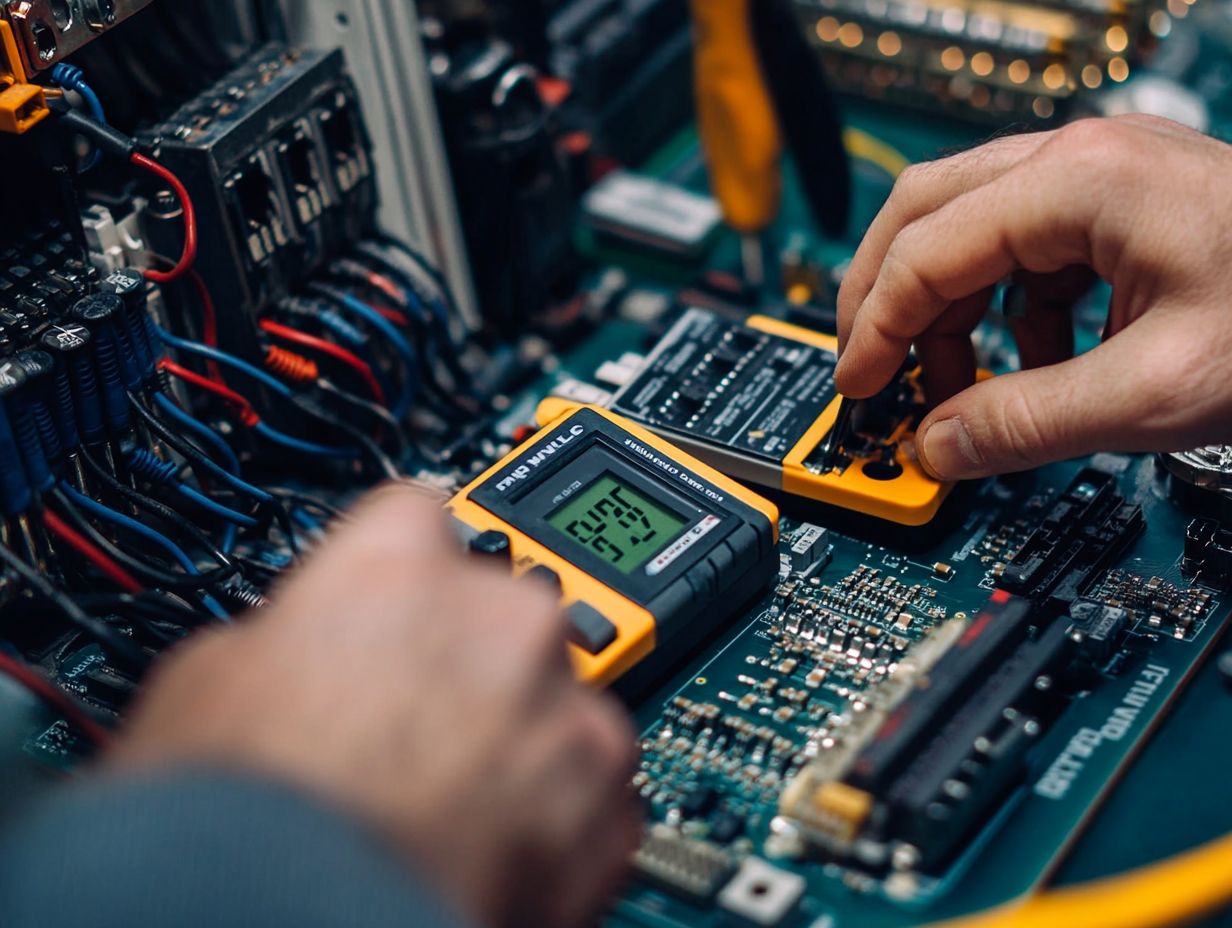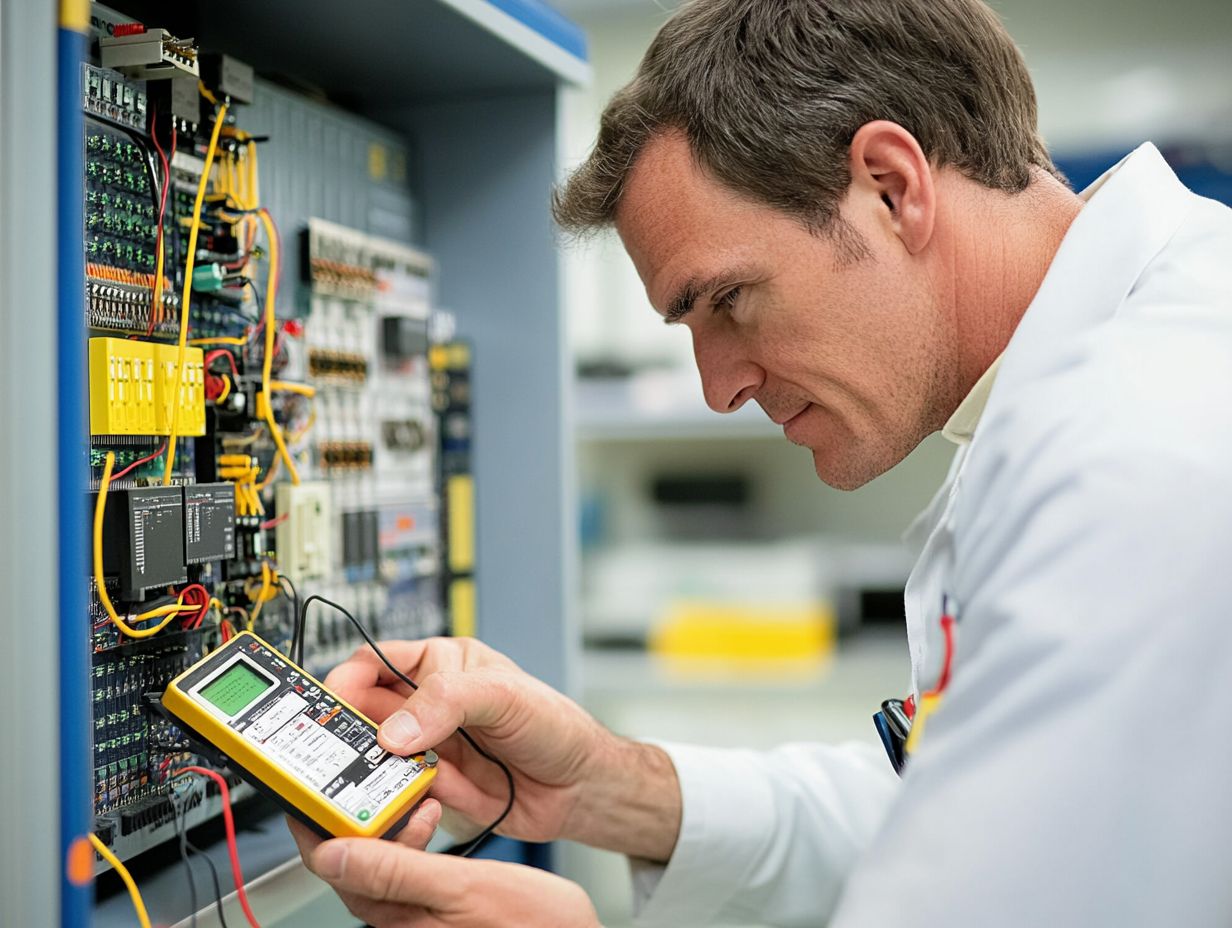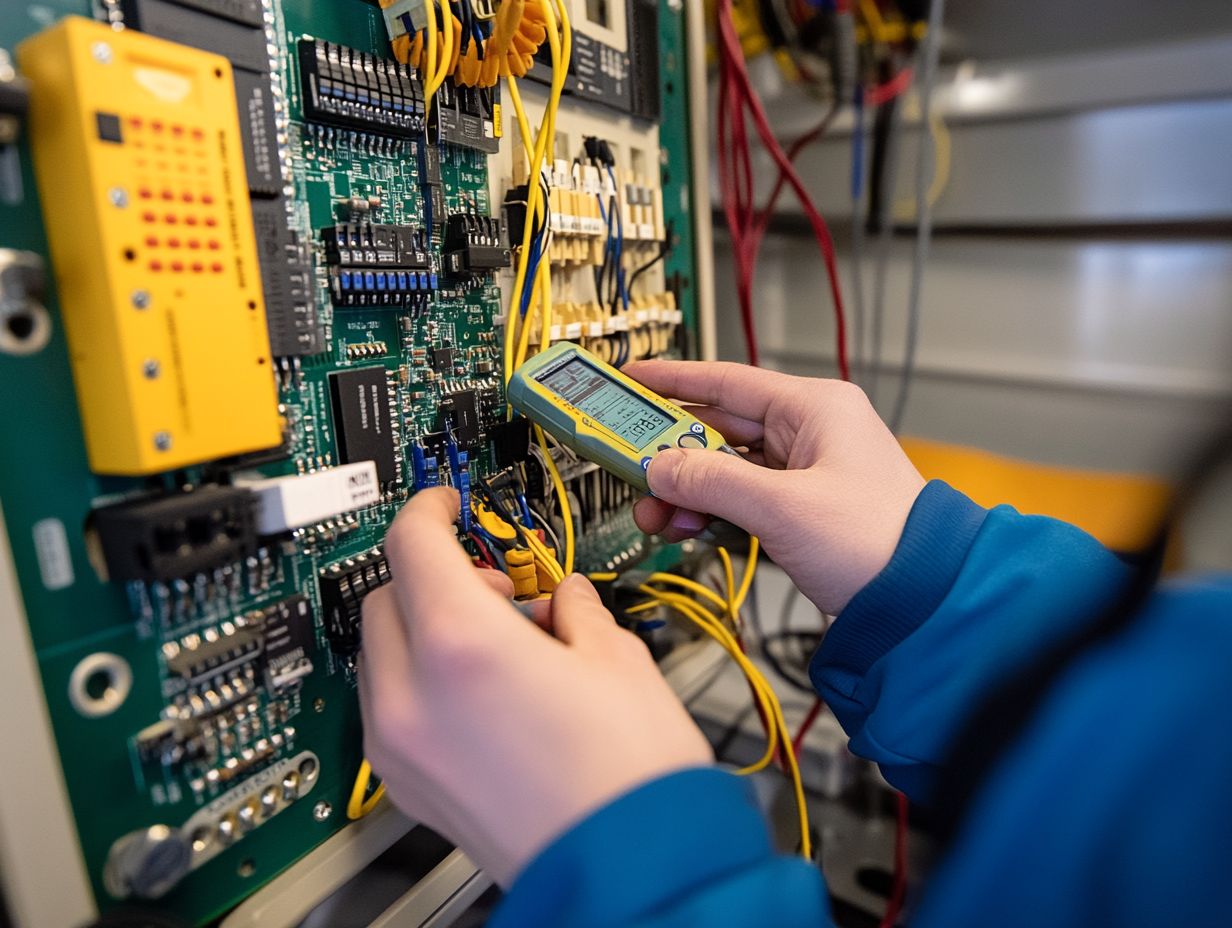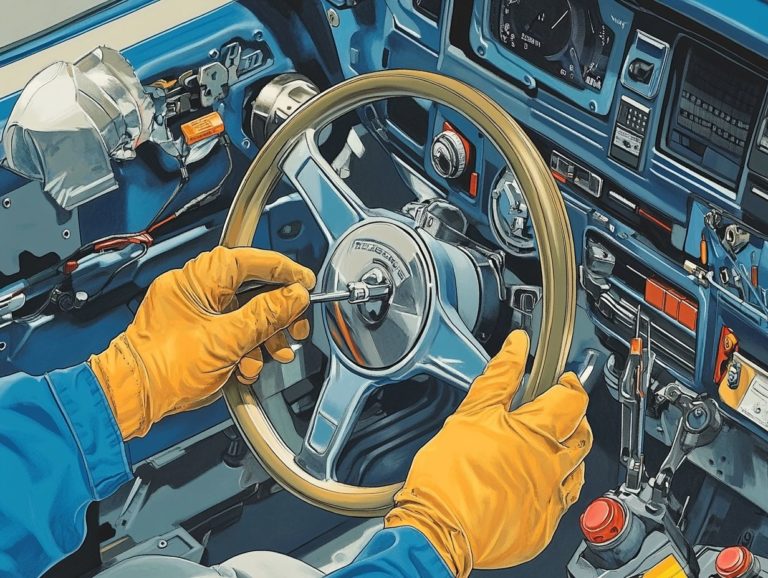How to Diagnose Common Electrical System Issues
Electrical system issues can be a significant source of frustration for car owners, often leading to unexpected breakdowns and costly repairs. Recognizing common warning signs is crucial for early detection and prevention.
This guide provides a step-by-step process for diagnosing problems such as short circuits, dead batteries, and faulty alternators. You’ll find detailed insights into the essential tools required, effective troubleshooting techniques, and preventive measures to ensure your electrical system operates smoothly.
Dive in to equip yourself with the knowledge you need to confront these challenges with confidence!
- Be aware of common warning signs, such as flickering lights or strange noises, to help diagnose electrical system issues early on.
- Follow a step-by-step process and use essential tools, like a multimeter (a tool used to measure electrical voltage, current, and resistance), to accurately diagnose specific issues like short circuits or a dead battery.
- Regular maintenance, like cleaning battery terminals, can prevent future electrical system issues and save you time and money in the long run.
Contents
Common Warning Signs
Recognizing common warning signs in your car’s electrical system is essential for preventing more serious issues down the line. Symptoms such as dim or flickering lights, malfunctioning accessories, and blown fuses are often the first indicators that something isn’t quite right.
By conducting regular visual inspections, you can catch these problems early. This ensures your vehicle remains in peak performance and safety condition. Battery issues, in particular, can escalate into major electrical faults if ignored, affecting everything from the ignition system to your power windows and audio system.
Don’t wait! Get help from a qualified technician at a trusted automotive service center.
Diagnosing Electrical System Issues
Diagnosing electrical system issues in your vehicle requires a methodical approach that combines visual inspection with specialized tools. When faced with challenges like issues with the flow of electricity or excessive current draw, your ability to troubleshoot effectively becomes crucial in pinpointing the root cause of electrical faults.
Using techniques like multimeter testing allows you to assess electrical parameters, uncovering hidden issues within the fuse box or wiring diagrams. A thorough examination not only ensures that your car’s electrical system operates smoothly but also safeguards against complications and enhances overall vehicle safety.
Step-by-Step Process
The process for diagnosing electrical system issues begins with a meticulous visual inspection of all critical components in your vehicle, including connections and terminals. For detailed guidance, refer to our resource on how to troubleshoot common electrical issues. This thorough assessment enables you to identify visible signs of wear or damage that could lead to electrical faults.
Check for frayed wires, corroded terminals, and loose connections that might result in intermittent failures. Experienced technicians will also pay close attention to the condition of connectors and grounding points, as poor connections can significantly impact overall performance.
Once you’ve completed the visual inspection, the next step involves utilizing a multimeter. By measuring voltage drop across specific circuits and checking the alternator output, you can effectively diagnose deeper electrical issues that may not be immediately apparent.
Comparing your readings against manufacturer specifications allows you to interpret results accurately, ensuring that no crucial element goes unchecked. This systematic approach not only enhances your troubleshooting accuracy but also optimizes the reliability of your vehicle.
Tools and Equipment Needed
Equipping yourself with the right tools and equipment is crucial for effectively diagnosing and repairing electrical system issues in your car. A reliable multimeter is a critical tool for measuring voltage, current flow, and identifying electrical faults.
Having access to car repair tools such as specialized electrical testing equipment and detailed wiring diagrams can greatly enhance your troubleshooting abilities. Whether you’re a DIY enthusiast or a seasoned professional, possessing the right gear transforms your capacity to ensure that your vehicle’s electrical components operate at their best.
Essential Tools for Diagnosis

Essential tools for diagnosing electrical system issues in your vehicle include a multimeter, which is crucial for measuring voltage, current, and resistance.
Alongside this, you’ll want various electrical testing equipment designed to accurately pinpoint faults. These tools help you troubleshoot complex electrical problems, ensuring you can identify and address issues with efficiency.
The effectiveness of car repair hinges on having the right equipment at your fingertips, allowing for precise diagnosis of critical components like the starter motor, battery, and alternator.
In addition to the multimeter, oscilloscopes are key players in visualizing electrical signals. They help you spot irregular waveforms that might signal underlying issues.
Scan tools are invaluable as they interface with your vehicle’s computer system, retrieving error codes and real-time performance metrics, simplifying the identification of malfunctioning sensors or relay systems.
Circuit testers and battery testers further elevate your diagnostic process, permitting a thorough examination of electrical connections and battery health. Collectively, these tools form a comprehensive toolkit that gives you the power to deliver exceptional service and ensure optimal vehicle performance.
Specific Electrical System Issues and How to Diagnose Them
Addressing specific electrical system issues requires a keen understanding of the symptoms and diagnostic methods tied to each problem, such as a dead battery, a faulty alternator, or a malfunctioning starter.
Each of these conditions presents its own set of challenges when it comes to troubleshooting and repair. For example, a dead battery may simply need a jump-start or replacement, whereas diagnosing a faulty alternator often involves checking voltage output and system grounding.
Accurately identifying these issues is essential for restoring your vehicle’s electrical performance and ensuring its long-term reliability.
Short Circuits
Short circuits are a common challenge you may encounter in automotive electrical systems, often leading to blown fuses or the malfunction of various electrical components.
To identify a short circuit, start with a thorough visual inspection of the electrical connections and wiring. Look for any signs of fraying or damage. Once you pinpoint the issue, troubleshooting might involve isolating the circuit and using a multimeter to check for continuity, allowing you to effectively locate the fault.
Knowing what causes short circuits helps keep your car’s electrical system safe. Short circuits occur when electricity strays from its intended pathway, often creating a low-resistance connection that results in excessive current flow.
You might notice symptoms such as flickering lights, erratic electrical components, or even smoke coming from damaged wiring. The potential causes of these issues typically range from insulation deterioration to moisture intrusion, both of which can compromise the system’s integrity.
During troubleshooting, utilizing diagrams to trace circuits and checking for any loose connections can help you identify specific areas of concern, ensuring that your vehicle s electrical system remains safe and fully functional.
Don t wait! Gather your tools and dive into diagnosing your car’s electrical system today!
Dead Battery
A dead battery ranks among the most common electrical issues you ll encounter in your vehicle. You might notice signs like dimming lights or trouble starting the engine. To diagnose a dead battery, start with a visual inspection of the terminals for any corrosion and ensure those connections are snug.
Next, grab a multimeter a device for measuring voltage and current to measure the battery’s voltage. This will help you determine if the battery is truly dead or just needs a recharge. Spotting these symptoms early can spare you from future inconveniences and contribute to the longevity of your vehicle’s electrical system.
Pay attention to any strange sounds, like rapid clicking when you try to start the engine. This can be another clue that something s wrong with the battery. If you find yourself making multiple attempts to start the vehicle with no success, examine the alternator as a malfunctioning one can drain your battery faster than you might think.
If you’re unsure, getting professional help is a smart move.
Regular maintenance checks are invaluable; they can help identify potential problems before they escalate, ultimately extending the life of your vehicle’s electrical components.
Faulty Alternator
A faulty alternator can significantly disrupt your vehicle’s electrical system. Symptoms include dimming lights, flickering dashboards, and malfunctioning power accessories.
When you notice these warning signs, it s essential to act swiftly to prevent further damage. To begin diagnosing the issue, use a multimeter to measure the alternator’s output while the engine is running. A proper reading should fall between 13.5 to 14.5 volts, indicating that the alternator is operating correctly. If the voltage dips below this threshold, your alternator might be on its last legs.
Conduct visual inspections for frayed wires, corroded terminals, or loose connections that could impact performance. By carefully following these diagnostic steps, you can determine whether the alternator is the culprit behind your electrical woes.
Malfunctioning Starter

A malfunctioning starter can leave you stranded. It often shows symptoms like a clicking sound or a complete failure to engage when you turn the ignition key. To diagnose a faulty starter, check the starter motor and its connections, typically using a multimeter to test for voltage and current flow.
Other signs include dimming dashboard lights or a grinding noise, which may indicate problems beyond the starter itself, such as a faulty battery or corroded wiring. The initial diagnostic phase should involve visual inspections for loose connections or damaged cables, as these factors can contribute to starter malfunctions.
If these basic checks don t resolve the issue, consult an automotive technician who specializes in starter motors. They can perform a bench test testing the starter outside the vehicle to pinpoint the problem more accurately, guiding you toward the most effective repair options, whether it’s a simple fix or a complete starter replacement.
Troubleshooting and Fixing Electrical System Issues
Troubleshooting and resolving electrical system issues in your vehicle demands a meticulous approach that combines effective solutions with practical repairs. It s crucial to identify the root cause of problems like short circuits or dead batteries to implement the proper fix.
Techniques include thorough visual inspections, precise multimeter testing, and consulting wiring diagrams to confirm that all components are operating properly.
This method improves your vehicle’s safety and boosts electrical performance, giving you peace of mind on the road.
Effective Solutions and Repairs
Implementing effective solutions and repairs for electrical system issues is essential for restoring your vehicle’s functionality.
Start by identifying the symptoms perhaps you ve noticed dimming lights or an unresponsive starter. Using diagnostic tools, such as a tool that measures electrical voltage, can help you pinpoint specific faults. This allows you to determine whether the problem lies within the wiring or a particular component.
Once you have confirmed the issue, your next steps should involve checking the battery charge and connections. A weak battery often sparks broader electrical malfunctions. If you re more experienced, consider directly inspecting the alternator s output and ensuring all grounds are secure. This can save you time and prevent unnecessary parts replacements.
By employing proper car repair methods, you not only facilitate repairs but also gain a deeper understanding of your vehicle s electrical system. Ultimately, this enhances its overall performance and lifespan.
Preventive Measures for Maintaining Your Electrical System
Implementing preventive measures is essential for maintaining your car’s electrical system. This ensures both longevity and reliability. Regular visual inspections of crucial components, such as battery terminals and wiring connections, allow you to identify potential issues before they become major problems.
Adopting good vehicle maintenance habits, like keeping the battery charged and ensuring proper system grounding, greatly reduces the risk of electrical faults. By embracing a proactive approach, you ll enjoy better performance and safety!
Proven Tips to Keep Your Electrical System Trouble-Free!
To steer clear of common electrical system issues, adopt several practical tips that promote effective maintenance and troubleshooting. Ensure your battery terminals are clean and tight, regularly check for blown fuses, and maintain proper grounding. These steps can significantly prevent electrical faults.
Keeping wiring diagrams handy will help you identify issues swiftly, leading to more efficient repairs and enhanced automotive service.
Regularly inspect cables for wear and tear, and schedule routine checks with a professional to further strengthen your electrical health. Utilizing high-quality components and sticking to manufacturer guidelines during replacements preserves performance and enhances safety.
Stay alert to dashboard warning lights, as they often signal electrical malfunctions that require immediate attention. Investing in surge protectors can shield sensitive components from voltage spikes, ensuring their longevity.
By implementing these strategies, you can maintain a robust electrical system that supports optimal vehicle performance.
Frequently Asked Questions

What are common signs of electrical system issues?
Common signs of electrical system issues include flickering lights, blown fuses, dimming headlights, and difficulty starting the vehicle.
How can I diagnose a dead battery?
To diagnose a dead battery, use a voltmeter to test the voltage. A healthy battery should have a voltage of around 12.6 volts.
What should I do if my car won’t start?
If your car won t start, check the battery, starter, or alternator. You can try jump-starting the car or have a professional diagnose the issue.
How can I determine if my alternator is bad?
You can perform a simple test using a multimeter to check the voltage output of the alternator. If it is consistently below 13.8 volts while the engine is running, it may indicate a bad alternator.
What are some common causes of electrical system problems?
Common causes of electrical system problems include aging components, corrosion, loose connections, and faulty wiring. Extreme weather conditions can also contribute to electrical issues.
Can I diagnose and fix electrical system issues on my own?
Depending on your experience and knowledge, you may be able to diagnose and fix simple electrical system issues on your own. However, for more complex issues, it is recommended to seek the help of a professional mechanic.
Check your vehicle today to ensure its electrical system is in top shape!






